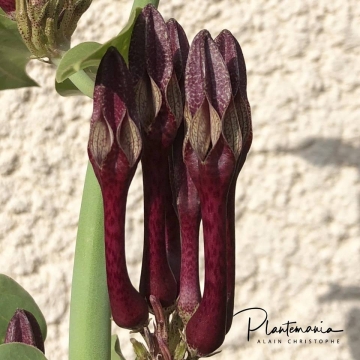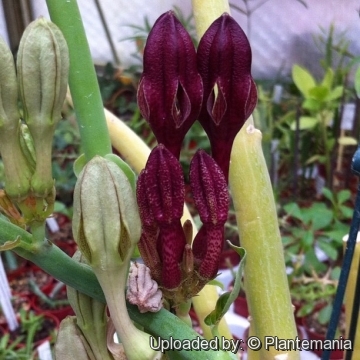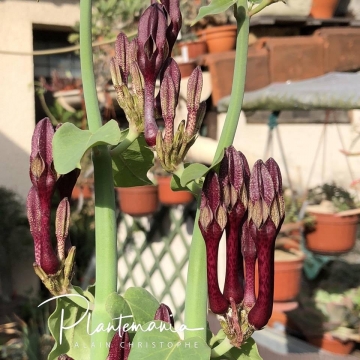




Your support is critical to our success.

Origin and Habitat: Ceropegia rupicolaSN|11038]]SN|32219]] comes from Yemen (W-Yemen, Aden Desert) and has been known since 1889. It is also been reported from southern Saudi Arabia.
Altitude range: 1600-2000 metres.
Habitat and ecology: Ceropegia rupicolaSN|22135]]SN|32219]] grows on rocky outcrops in the Yemen mountains associated with several other succulent species such as Euphorbia cactus (the dominant species), Euphorbia parciramulosa, Euphorbia fruticosa, Euphorbia schimperi, Caralluma cicatricosa, Caralluma hexagona, Aloe yemenica, and Aloe menachensis, just to cite a few of the more common. Ceropegia rupicola has succulent stems, showing adaptative convergence in vegetative characters with disjunct Canary Islands species such as the most succulent shrubby Ceropegia dichotomaSN|32219]]SN|22135]] and Ceropegia fuscaSN|32219]]SN|11038]]. C. rupicola also has been seen as a twiner in Saudi Arabia.
Synonyms:
- Ceropegia rupicola Deflers
Ceropegia rupicola Deflers
Voyage Yemen 167 1889.
Accepted name in llifle Database:
Ceropegia rupicola var. stictantha N.P.Taylor
Cact. Succ. J. Gr. Brit. 42(4): 111. 1980
Description: Ceropegia rupicola is a plant with succulent leaves and basally branched trailling stems thick as a finger. From its apex annual inflorescences with very odd flower are produced in spring, the linear corolla-lobes are whitish or pinkish and blotched with red-brown, united at the tips into a pyramidal roof, openings slit-shaped to ovate, but sometimes breaking free. The unusual barbell shaped flowers with their tiny slit openings are about 5 cm tall and about 12 mm in diameter at the widest part.
Derivation of specific name: The name means 'inhabits rocky places'.
Stems: Basally branched. Branches 30-70 cm long , 8-12 mm in diameter, curved, erect, cylindrical, with internodes slightly compressed, occasionally longer than 1 metre and trailling, later procumbent, glabrous, grey-green to bluish pruinose.
Roots: Fibrous.
Leaves: Opposite, slightly succulent, caducous, short stalked, ovate-lanceolate to cordate-ovate, 1.5-6 cm long, 1-4 cm wide, tapering, glabrous, margins finely ciliate.
Flowers: 10-14 together in shortly pedunculate pseudo-umbels towards the tips of the branches (usually with 2-4 flowers simultaneously open). Pedicel c. 5 mm long and 2 mm in diameter. Sepals lanceolate-linear, 2-5 mm long, acute. Corolla 3.5-6 cm long, tube somewhat expanded at the base, lobes lanceolate, united up to half way, outer surface pale pink with red-brown blotches on whitish-greenish background, base whitish with-out blotches, inside red-brown, glabrous. Corolla inflation ovoid, 6-9 mm in diameter, basally slightly compressed, enclosing the gynostegium. Corolla tube about 25 mm long and 3.5-4.5 mm in diameter, inside hairy, towards the mouth gradually widening to about 12 mm. Flower tubes draw insects to ensure pollination. Corolla-lobes whitish, outside blotched with red-brown, inside marked with a fine reticulation, triangular, 7 mm, tips fused into a pyramidal roof, openings slit-shaped to ovate. Corona pale pink, 5 x 4.5 mm, almost sessile, tuned into a cup, with long hairs on the margin.
Fruits: Two-horned follicles, pale green, cylindrical, c.12 cm long and 4 mm in diameter.
Seeds: 8-10 long, 3-3.5 mm broad.
Related species: Ceropegia rupicolaSN|32219]]SN|32219]] is morphologically fairly isolated, but most closely related to Ceropegia aristolochioides from Arabia and Sudan.
Bibliography: Major references and further lectures
1) S.A. Ghazanfar, M. Fisher “Vegetation of the Arabian Peninsula” Springer Science & Business Media, 17 April 2013
2) Hermann Jacobsen “Abromeitiella to Euphorbia” Blandford Press, 1960
3) Philip Mathew, M. Sivadasan “Diversity and taxonomy of tropical flowering plants” Mentor Books, 1998
4) Focke Albers, Ulrich Meve “Illustrated Handbook of Succulent Plants: Asclepiadaceae: Asclepiadaceae”, Volume 4 Springer Science & Business Media, 2002
5) J R I Wood "A Handbook of the Yemen Flora" plate 191977-1979
6) Sheila Collenette “The ceropegias of Saudi Arabia” British Cactus & Succulent Journal Vol. 17, No. 4 (December 1999), pp. 181-187
7) Rawiya Alasbahi, Matthias Melzig “The In Vitro Inhibition of Human Neutrophil Elastase Activity by some Yemeni Medicinal Plants” Sci Pharm. 2008; 76: 471–483
8) Taylor, Np, 1980 “A new variety of Ceropegia rupicola.” Cactus and succulent journal of Great Britain 42(4): 111-112

Ceropegia rupicola Photo by: © Plantemania

Ceropegia rupicola in its habitat. Photo by: © Plantemania

Ceropegia rupicola (white and red form) Photo by: © Plantemania

Ceropegia rupicola Photo by: © Plantemania
Cultivation and Propagation: Ceropegia rupicolaSN|32219]]SN|32219]] is easy to grow in full to part sun. It requires hot conditions and can be grown outdoor in mild climate where it proves to grow well semi-neglected. It is a plant with succulent leaves and very thick trailling stems. It does very well, and is resting and leafless, during the winter.
Water requirements: It needs regular watering, especially during the hottest summer days. During winter dormancy, the plant should be kept completely dry however provide some light watering if the green house temperatures in winter are elevated.
Soil: Use a very draining mineral potting substrate.
Repotting: This plant needs plenty of space for its roots, repotting should be done every other year or when the it has outgrown its pot. Use pot with good drainage.
Fertilization: Feed with a high potassium fertilizer in summer.
Pest & diseases: They are pest free outdoors, but may attract white flies or mealy bugs if kept in humid greenhouse environments, and some kind of control might be needed.
Frost Tolerance: Recommended minimum temperature is 5 -10°C or even above. It may be severely damaged when the temperature drop to near freezing, but even if most of the stems dye back, it usually sent out new shoots in spring from the base.
Traditional uses: Ceropegia rupicolaSN|32219]]SN|32219]], locally named “Bukira”, is used in Yemeni traditional medicine. It is applied externally for skin diseases.
Propagation: Seeds. Plants can also be propagated from cuttings.
| Your Actions | |
|---|---|
| Back to Ceropegia index | |
| Back to Asclepiadaceae index | |
 |
Back to Succulents Encyclopedia index |
Privacy stantement - Terms and conditions - How to cite - About us - Feedback - Donate




